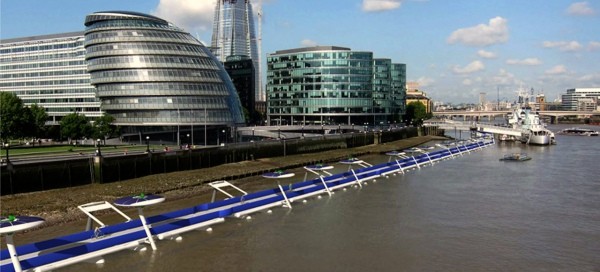The Thames River is London’s main transportation thoroughfare and has been from Roman times to the 19th century. It has been vastly underutilized as a travel artery except for a small number of tourist, commuter boats, and industrial transport — so why not a floating cycling highway?
Outside the Box
London has proposed the floating cycling highway on the Thames river as a perfect example of thinking outside-the-box to solve deep-seated traffic and pollution problems. The new proposal challenges conventional transportation with it’s unique design because it floats entirely on water.
The Thames Deckway Project
The floating cycling highway is for everyone. The mission of the Thames Deckway crew is to provide a state-of-the-art, traffic-free bicycle and pedestrian pathway through the heart of London for commuters, city dwellers, and visitors to enjoy. The Thames Deckway will generate its own energy from a combination of sun, tide, wind, and be entirely non-polluting.
Untapped Potential
“The Thames offers vast, untapped potential to ease and improve London’s infrastructure problems. What is needed is imagination to unleash it.” Said an unnamed member of the consortium. Claims are made that the cycle journey along its route will be 30 minutes quicker than the same journey on roads.
It’s For Everyone
Designed for commuter cyclists, leisure cyclists, and pedestrians alike, the bicycle highway will remain completely traffic-free. It will potentially stretch for 12 kilometres along the river from Battersea to Canary Wharf, a distance that a fit cyclist can pedal in about 30 minutes. From either Battersea or Canary Wharf to the Thames Deckway’s prospective mid-point of the Millennium Bridge, it could take as little as 15 minutes on a bike.
The Design
The proposed Thames Deckway will run close to the river’s edge but remain well away from the navigation channel. It will rise and fall gently with the Thames’ tides. There will be embankment ramps at strategic intervals and lots of stopping points along the way for the views and to relax at refreshment stations. The route’s on and off-ramps will go around the HMS Belfast, or avoid other moorings along the route that have not yet been revealed.
Safety on Water
Safety and security of cyclists and pedestrians is the number one priority for the floating cycling highway. Traffic density, traffic flow, river motion, river wave, and any hazardous traffic or weather conditions will be monitored continuously by satellites. Weather stations and on-board sensors will relay information directly to the Thames Deckway’s users.
A Fleet of Bikes
The Thames Deckway plans to host its own bicycle fleet, tailored specially for family use and offering infant carriages, child bicycles, tandems, and tricycles for hire. Commuter cyclists will use it during rush hours.
Funding, Always an Issue
River Cycleway’s initial focus is on tracking down funding for a detailed study of the project’s environmental, operational, constructional, and financial feasibility as the first vital step. With a positive feasibility study outcome followed by private project financing, design, engineering, and regulatory and environmental approvals, a streamlined construction program could have the first Thames Deckway phase in place and ready for London’s cyclists and pedestrians in as little as two years from full go-ahead.
Self Supporting
The Thames Deckway concept is an independent environmental and social impact venture. It can be built with private investment attracted by the appeal of its long-term financial return prospects. River Cycleway’s financial projections show that it will cost approximately £600 million ($984.42USD ) to build from Battersea to Canary Wharf. With a flat rate single ticket price in the region of £1.50 ($2.50USD) it has considerable potential as a generator of healthy, sustained revenues.
Floating Cycling Highway
Big cities all over the world are beginning to realize that bicycles are old technology with a bright future. Non-polluting, inexpensive, and faster, bicycle highways and the optimization of existing bike paths represent the future of individual transportation. Some of the solutions are evident. Germany has already introduced the biggest and sweetest cycling highway ever. Just like an Autoban, Germany’s superhighway is for bikes only. Cable suspended bike paths, also sometimes referred to as floating highways, are futuristic designs that may be appearing in big cities near you in the not too distant future.
